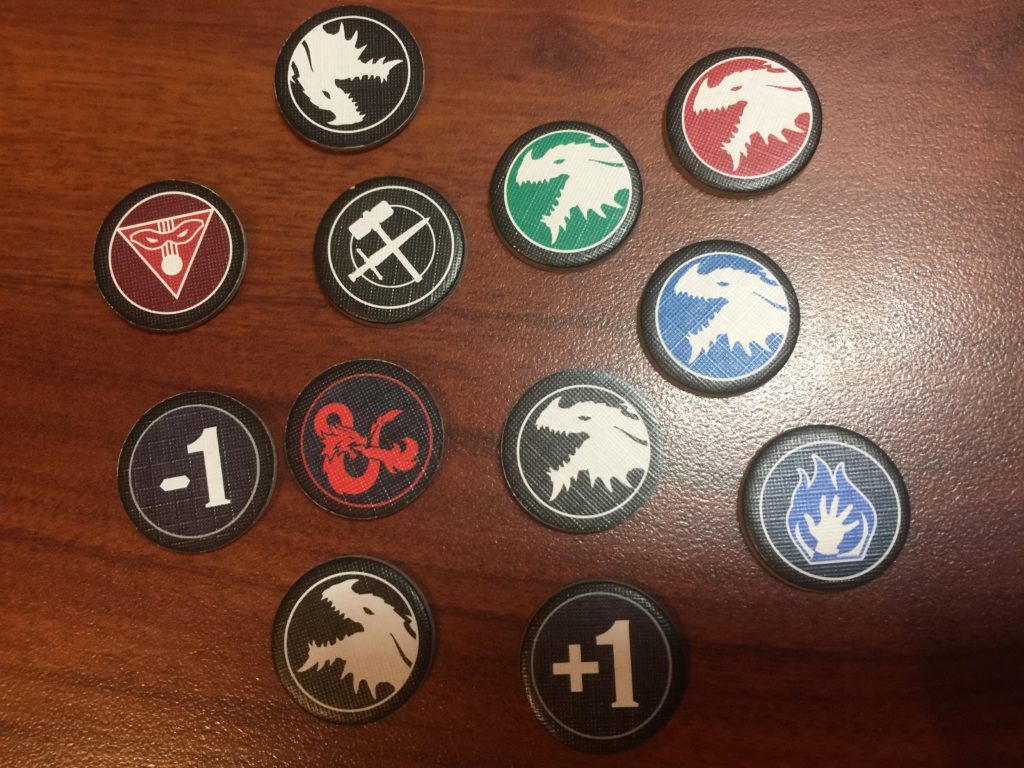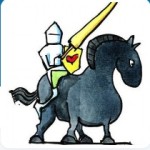Rocky Played Dragonfire
Rarely does a game come along that I have been truly ecstatic about its release. Dragonfire is that game for me and I’m sure after I tell you why I love it, you’ll love it too. Allow me to explain.
I love cooperative games. I’m not talking about a game that is mostly cooperative but secretly there’s a traitor in your midst, such as Battlestar Galactica, Shadows Over Camelot or Dead of Winter. I’m also not talking about a game that is cooperative for the majority of players but everyone is up against one other person, such as Descent or Imperial Assault. I’m also not talking about team cooperative games where you are working together with the other people on your team against the other team that is made up of other players, such as Good Cop Bad Cop, Avalon or even Are You a Werewolf? I do enjoy all of those games but a type of game I truly, madly, deeply love is the true cooperative game where my friends and I up against the game itself. Dragonfire is one such game.
I also love a great deck-builder game as well. I have several deck-builders in my collection, Star Realms, Thunderstone: Advance, Hero Realms and Friday and although the first three on that list bring out my competitive side (Friday is a Solo romp) and I come back to them a lot, they don’t provide the true cooperative game experience.
Catalyst Game Labs did a partial release at Gencon this year and that is where Michael of The RPG Academy was able to pick it up. As of this writing we have played the game on several occasions for multiple hours each time and my excitement for buying my own copy has not waned.
Dragonfire is not an original concept of a game as it runs mostly off the Crossfire engine and in my opinion improves on it. I think that improvement is key and it’s what I want to focus on. But first, where does the name Dragonfire come from (other than the evocative imagery and obvious connection to WotC)? – The Dragonfire Deck.
The Dragonfire Deck – at the start of the party leader’s turn you’ll flip a Dragonfire card and do what it says. If you haven’t defeated every encounter (normally at least one per player) then you discard it in the Dragonfire discards and it increases the Dragonfire Level. Oh yeah, that’s a bad thing. Some of the Dragonfire cards have a dragon’s head and a number denoting a Dragonfire Level. You do everything on the card and if the Dragonfire Level (the number of cards in the discard) is equal or greater than the number of cards in the Dragonfire discards then more bad stuff happens.

This Dragonfire card has three possible effects – Nothing happens if the Dragonfire level is 2 or less (so 2 or fewer Dragonfire cards in the discard) the first effect happens if the Dragonfire level is 3 or 4 and the third effect happens if the Dragonfire level is at 5 or higher.
If you’d like to watch us do a play through of one of the early campaign adventures you can do so here
Some of the improvements on Shadowrun Crossfire are the vast number of cards, the number of Adventure Cards increasing from 3 to 8, the leveling up system and the way experience is earned as well as adding Magic Items as rewards.
So what do I mean by the vast number of cards. In Shadowrun Crossfire there was a 40 card Normal Obstacle (Encounters in Dragonfire) Deck as well as a 40 card Hard Obstacle Deck. In Dragonfire the base game alone comes with five 20 card Encounter Decks; Dungeon Difficulty 1, Dungeon Difficulty 2, Wilderness Difficulty 1, City Difficulty 1 and Adventurers Difficulty 2. As well as six Difficulty 3 Encounters. The great thing about this is that these Encounter Decks are already being added to and creating new ones in expansions but even with just these my second improvement becomes more important.
There are eight Adventure Cards included in the base Dragonfire Game vs. three Mission Cards in Shadowrun Crossfire.

Here is an example of an adventure card. It gives you details as to which encounter decks to use and any special rules for the encounters (this one had none). The other side (not shown) will give details on the rewards earned for completion as well as ways to change it up and with optional encounters or to make it more/less difficult based on the level of the party.
These adventures are significantly different than each other from what we’ve seen and seven of them have been linked into a Campaign in Dragonfire which is a cool addition. The missions play very differently. The first adventure we did was the Dungeon Delve, almost an exact replica of the Crossfire mission in Shadowrun Crossfire. For both of these games they could have included just these adventures/missions and everyone would have been happy. You see, ANY of the Difficulty 1 Encounter decks can be used along with any of the Difficulty 2 Encounter decks making for a larger variety of play within the same Adventure. This doesn’t include the mix and variety of Dragonfire cards that will change the way each round and scene plays out. There are 24 Dragonfire cards included in the Base Set and more are expected to be added with already planned expansions.
What about the variety of Adventures I mentioned? The first campaign adventure we were up against an encounter per person and several tokens (also a new addition to Dragonfire), while the second one had us as a bodyguard for the noble we had rescued and each round the baddies would go after the noble and we had special rules that allowed us to pull them away or we could deal with them as if they were another player. Looking through the Adventures I saw one that the card acted as a portcullis and we were defending a gate and eventually that portcullis would burst.

A sélection of the tokens used in the games. The ‘Dragon Head’ tokens are used for enemies, the -1/+1 are used (as you’d assume) to denote an encounter with change to it’s attack power. The Dragon& token is used to denote when an encounter is not able to attack (you cover it’s attack value) or when it’s not worth any gold (cover it’s gold value).
So if you’ve never played Crossfire, then the earned experience will just seem right as opposed to seeming to be really slow in Crossfire. Each scene that you are in (there are normally three scenes per adventure) you normally get one experience point plus two bonus experience if you are successful in the adventure. Shadowrun Crossfire was much more brutal, sometimes with you being lucky to get experience at all. So what do you spend experience on? In true Dungeons & Dragons form you get to get background stickers (Soldier), class stickers (Fighter: Second Wind, subclass stickers (Eldritch Knight), general/feat stickers (Toughness). That’s not the only great reward for playing, Dragonfire has added Magic Items! Everything from the Healing Potion to the Blessed Full Plate is inside. Like I said, this is a deck-builder so once you have your starting deck (different for every class, race and sub-race combination) then you can choose to shuffle your magic item you’ve earned in as well. I had a Longsword +1 that I got with my Detect Magic Scroll (basically lets you get a more powerful magic item for this game only. This normally does two colorless damage but because I was the Martial character it did two Martial (black) damage instead.

An example of one of the character cards. Each has a race/class combo and may have a special ability (this one has Infernal Legacy). Along the top you have your Hit Points. The game comes with a bunch of ‘clips’ you can use to denote current HP as well as tracking damage on the encounters. The white icon with the # 4 here represents how many cards make up your starting hand. The yellow # 4 icon below that is your starting gold The red ‘heart’ icon with the # 8 indicates how many Hit Points you start with. The 3 blank spaces on either side of the card is where you place the improvement stickers you purchase with your earned experience points.

Here you can see some examples of the ability stickers you can purchase with your earned experience points. The top left space on your sheet is free and you get a free ‘background’ sticker when you complete the starter adventure. You have to pay XP to unlock the other spaces and then purchase stickers to go there. If you cover a sticker you can use it’s original cost towards the cost of the new (like more expensive/better one).
This game brings a lot to the table that I can’t cover in depth without making this the longest review ever. Besides what I’ve already discussed I’d like to at least mention these notable greats of this game. The “starter decks”, called Equipment Packs are different for almost every character. If they aren’t different then they will be as you acquire magic items (that are added to your starting deck and stickers (that sometimes modify Equipment Packs). Unlike a lot of deck-builders when you buy a new card it goes straight into your hand and that’s an empowering feature that makes you feel good for defeating encounters. Unlike Thunderstone Advance, Dominion, Star Realms or Hero Realms there is no currency to buy cards in your deck/Equipment Pack. You start the game with some gold and like a true adventurer you have to earn it by defeating Encounters. The flavor and theme of this game really shines and the magnificent artwork helps with this as well.

Here are the four basic cards that make up your staring equipment pack. Based on your race/class you will have a specific number of each (look back up at the character sheet image above and you can see that character would start with four Grace cards, one Martial Card, two Stealth Cards and one Cantrip card). These are all ‘basic’ cards and can only be played when it is your turn (though they can be played on encounters facing other players – we messed that up for a bit). As you buy new/better cards from the market place they go directly into your hand and do damage and often have additional effects.

Here is a sampling of three encounters from the Dungeon 1 deck ( the little M looking icon at the bottom means dungeon and there being only one, it’s Dungeon 1). Looking at the Red Salad First – when it comes out it has a surprise effect – Dispel magic. If you have a magic item out in play it would get discarded. Next it has a vanquished effect which occurs if/when this encounter is defeated. It must SAVE. To SAVE you draw the top card of the deck this creature came from (Dungeon 1 in this case) and if the card drawn is of the same color (red here) then it SAVES, any other color and it fails. Additionally sometimes players will also have to SAVE and uses the same mechanic- you must draw from your deck and match your primary color). If the Red Slaad passes it’s save, it summons another Salad from the same deck it came from. If there are no other Slaad (they are already on the board or defeated) then you summon the top card (you bury the card you drew for the SAVE). Continuing with the Red Slaad – to defeat it you must first do four points of damage (of any color), then three points, then one Deception (or Red) damage and finally another Deception damage. You do not need to do this all in one turn, but damage does not carry over. So, for example, if you did two points of damage (any color) and are not able to get another two to take out it’s first level then after your turn it goes back to full health at that level). Next let’s look at the Gibbering Mouther – it has increased strength depending on the Dragonfire level. Normally it’s last two levels are 1 colorless and 1 colorless, but if the Dragon fire is at 6 – 8 then those last two levels are now 3 and 3. At 9 plus they are 5 and 5. This card also has a “tripwire’ ability. See how there is a line underneath that first Arcane/Blue damage level? After that creature is damaged below that line (so not the level above, but once you go below) it triggers its Tripwire ability, which in this case is Terror – Terror means the player that encounter is facing can only play one card on their turn and may not play assist cards – this is creature you want to try and take out in one turn. Lastly, we’ll look at the Location Encounter – Choke Point. When a location encounter is drawn the player it’s in front of has their token placed on it to indicate they are in that location. That means other players can not assist that player unless they (on the start of a turn) also move themselves into that location and are under the effects (if any) – in this case those players are unable to play more than two cards on their turn. Notice those yellow icons at the upper left of each encounter? That indicates how much gold you earn for defeating that encounter. You start with the active player and go around the table so if you have four players in the game when you defeat the Red Slaad, then the active player and the player to their left would get three gold each and the other two players would get two each. Or for either of the other two encounters the active player would get two gold and everyone else gets one.
The best thing about this game is that not only is it a truly cooperative and challenging deck-builder but it really captures the essence of helping and working with the other characters. The market deck has 60 cards in the Base Set and there’s more to follow in future expansions. These cards are purchased during one of the last steps of a turn, the Market Phase. Again, when you purchase the card it goes straight in your hand. There is normally a damage listed on the top left of the card and then some sort of ability written below the picture. On your turn you play the card and do the ability and then you apply the damage to anyone’s encounters to help defeat them. But, several cards have assist abilities and an assist ability can ONLY be done during someone else’s turn. For instance, Bless does one Devotion (green) damage and has no ability if I play it on my turn. But, if I play it on someone else’s turn for its assist ability then I can deal a damage of ANY color. There are a lot of cards that have different assists then the damage and ability they would do on your turn and this is one of the things that add a significant amount of fun strategy to the game. This brings me back to when you buy a card during your turn, if it has an assist ability you can use it during someone else’s turn and that means that even when it’s not your turn you’re still actively engaged in the game and trying to help your friends. All of these combine to make for a truly wonderful cooperative experience.

Here is a sampling of the Market Cards: Each card has it’s cost in the top right corner. The ‘type’ of card is listed in the lower middle (Martial/Black, Devotion/Green, Deception/Red or Arcane/Blue). Flaming Oil does it’s damage (kinda hard to see, sorry – but there is one point of Martial Damage and one point of colorless – top left) and it deals that damage to every encounter facing a player. Great for taking out tokens. Spiritual Weapon costs 4 gold to but and does a Devotion/Green damage as well as 2 colorless. Also, if the player who is playing the card is of the Devotion Class then it may be played as an assist (on someone else’s turn) and still does a Devotion/Green and two colorless. Twist the Knife costs 5 gold and does two Deception/Red damage. But if you use it as an assist then it does one level of damage. That’s powerful, looking back up at our Red Slaad above, that means you could use just this card to deal that first level of damage (4 colorless). Misty Step costs 4gold to purchase and deals one Arcane/Blue damage and one Colorless and it allows you to discard up to three cards and then draw that same number, but if you are the Arcane class then you get to draw up to three cards and then discard that same number. This is a great card to let you get to your powerful cards quickly.

Here is a sampling of some of the magic items you can acquire by completing adventures. Some are ‘Consume’ meaning when you use them they are gone. Other remain in play. Some have a ‘Repack’ ability meaning you can discard them to draw a replacement card. The magic items are classified as Common, Uncommon, Rare and Very Rare.
When Catalyst Game Labs releases it I’ll be picking it up and if you do too please comment and let me know what you think?









2 pings